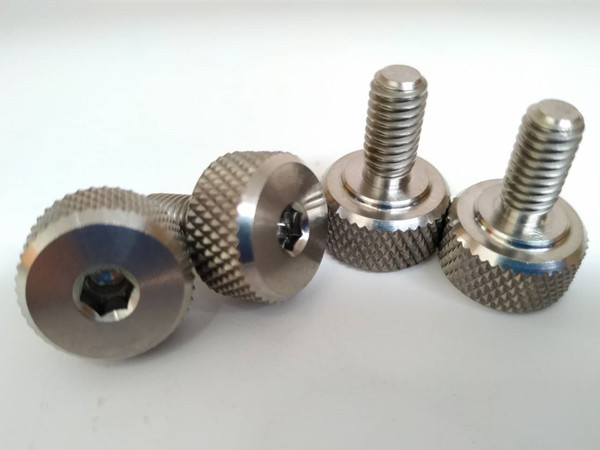Titanium alloy is a kind of difficult-to-process material with poor thermal conductivity, easy to adhere to tools, strong notch sensitivity and strong work hardening during rolling. In actual production, there are a series of problems in rolling full teeth. Firstly, after filling the gap between the two rollers in the rolling process, if the rollers continue to roll, the blank material has no place to flow and can only be extruded back and forth between the rollers. As a result, the thread has a higher surface hardening. When the hardening exceeds the tensile limit of the material, cracks occur, and the threaded teeth. The hardening of the side and the bottom of the teeth is the most serious, so cracks occur. Secondly, when full extrusion, each tooth of the roller involved in rolling is also affected by the strong cyclic load. The rolling energy also acts on the roller, so that the life of the roller is seriously reduced. In actual production, each roller can only roll 3000-5000 pieces of titanium screw. Bolts, there is a phenomenon of crown fragmentation, the roller can no longer continue to use, the cost is extremely expensive, in addition, the roof fragmentation of the roller has a formation process, so that producers can not determine the eligibility of rolling threads, that is, when rolling is qualified, when rolling is not qualified; third, forming a screw in rolling. In the process of thread, the two sides rise fastest, and a fold will be produced on the top of the tooth when the thread is full. There are fluorescent marks on the top of the thread during flaw detection. In order to determine the maximum defect depth, it is necessary to use anatomical method to determine whether the defect at the top of the thread exceeds the standard. Fourthly, the joint of modern fasteners has high fatigue. Labor life, for bolt holes have high accuracy requirements, in the installation process, no hole wall damage is allowed, and the tip of the screw thread is very easy to damage the hole wall. In a word, full thread profile brings great trouble to production. It not only increases the chance of cracking, decreases the fatigue life of parts, but also reduces the service life of the roller. Moreover, it brings unnecessary trouble to testing, and also easily causes damage to the hole wall. Therefore, it is necessary to correct the large diameter of the thread of titanium alloy fasteners. It’s imperative.

In foreign countries, such as all the titanium bolts in the United States and the latest standard of titanium bolts, the thread diameter has been revised, the thread size has been moved down, and the thread has adopted the unsaturated tooth type. Thread stress is mainly near thread diameter, and the downward movement of thread diameter is not expected to affect the mechanical properties of the bolt. In order to confirm this view, the author provides a basis for the correction of thread diameter of titanium alloy fasteners in China, and provides two representative hexagonal head titanium bolts with different thread diameters, HB6563.6 and HB6563.10. The mechanical properties were tested. Two kinds of bolts are adopted three kinds of large diameter size, and mechanical performance verification includes tensile, fatigue and stress endurance test.
Pure titanium reaches 800,000 pounds/inch 2 (5517 MPa) and alloy titanium reaches 180,000 pounds/inch 2 (1241 MPa), which is far higher than the strength of many alloy steels, so titanium has a high strength-weight ratio. Titanium has twice the elasticity of steel and is an ideal choice for applications requiring high fracture or fracture resistance. In addition, titanium alloy has higher corrosion resistance and oxidation resistance than stainless steel. Many properties of titanium make it suitable for most applications, but at the same time lead to its becoming one of the most difficult materials to process. However, a manufacturer who understands the characteristics of this material can successfully process titanium parts without having to pay a high price. Most titanium alloys have poor thermal conductivity. The heat generated in the machining process does not diffuse through the parts and machine tool structure, but concentrates in the cutting area. In some cases, the temperature reached as high as 2,0000 F (11093 C) may lead to edge collapse and deformation, while the blunt edge will generate even higher heat and further reduce tool life. Cutting temperatures can be so high that titanium chips sometimes burst into flames. The high temperature produced in the cutting process will also cause the workpiece to harden continuously, which will affect the surface integrity of titanium, and may lead to inaccurate geometric accuracy of parts, and seriously reduce their fatigue strength. The elasticity of titanium alloys, which is beneficial and necessary for the product, adds fuel to the deflection and vibration in heavy load cutting. Under cutting pressure, “elastic” material is removed from the tool. Therefore, instead of cutting, the cutting edge rubs, especially when the feed is small. This friction process also generates heat, aggravating problems caused by poor thermal conductivity of materials.
The forward cutting geometry is adopted to reduce cutting force, heat and part deflection. Constant feed is used to prevent work hardening. Never stop feeding in the cutting process. Use a large amount of coolant to maintain thermal stability and prevent temperature rise problems that may lead to irregular secondary surfaces and possible tool failures. Keep the tool sharp. The blunt knife will accelerate the temperature rise and cause the wear and tear phenomena which lead to the failure of the knife. Processing titanium alloys in as soft a state as possible. Because many alloys are age-hardened — they harden when heated — they become stronger and more abrasive when forming second-phase particles. As far as possible, larger radius of tool end or circular blade are used to make the tool enter the cutting more. This reduces the cutting force at any point and prevents local damage.
